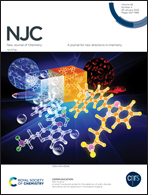Metal-free, one-pot synthesis of 2-styrylquinolines via Friedländer annulation and sp3 C–H activation using 1,3-dimethylurea and l-tartaric acid (3 : 1) as a deep eutectic solvent†
Abstract
A simple, metal-free protocol is reported for the one-pot synthesis of 2-styrylquinolines using a combination of 1,3-dimethyl urea (1,3-DMU) and L-tartaric acid (LTA) (in a 3 : 1 ratio) as a deep eutectic solvent (DES). The reaction proceeds via Friedländer annulation followed by Knoevenagel condensation (sp3 C–H activation) to give functionalized styrylquinoline derivatives in good to excellent yields. Density functional theory (DFT) calculations supported the experimental results on the role of DES in the enolization of the carbonyl compound (for Friedländer annulation) and the formation of enamine, key steps in sp3 C–H activation. Furthermore, the absorption and emission spectra of the resulting acyclic and cyclic compounds were recorded and it was found that compound 7c showed the highest emission band maximum (644 nm) due to intramolecular charge transfer. Also, compounds 7b and 8d exhibited a larger bathochromic shift at 551 nm and 558 nm, respectively, and compound 5n showed the highest Stokes shift (Δλ, at 182 nm). Compound 7e displayed noticeable colors in various solvents (solvatochromic effects). Some of the resulting compounds reported here can be used for developing fluorescent probes.



 Please wait while we load your content...
Please wait while we load your content...